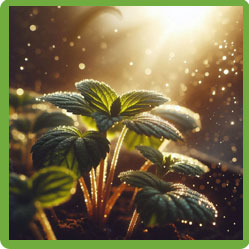
Transpiration
Transpiration is the process where water evaporates from the leaves of a plant, helping to pull more water up from the roots. It plays a vital role in moving water and minerals through a plant via the xylem. Learn how factors like temperature, light, humidity, and wind affect the rate of transpiration and how plants are adapted to control water loss.
Plant Cell Organisation and Tissues
Like animals, plants are made up of cells, which form tissues, which work together as part of organs and systems. Important plant tissues include:
- Epidermal tissue – covers the surface of the plant
- Palisade mesophyll – packed with chloroplasts for photosynthesis
- Spongy mesophyll – allows gas exchange
- Xylem and phloem – transport substances around the plant
- Meristem tissue – found at growing tips, where cells divide
Xylem and Phloem – Transport Systems
Plants have two key transport systems:
- Xylem tubes carry water and mineral ions from the roots to the leaves. They are made of dead cells and strengthened with lignin.
- Phloem tubes carry dissolved sugars made in photosynthesis to other parts of the plant. This movement is called translocation and it can go in both directions.
What Is Transpiration?
Transpiration is the loss of water vapour from the surface of leaves. Water:
- Is absorbed by the roots
- Travels up the xylem tubes
- Evaporates from the leaf surface
- Diffuses out through the stomata (tiny pores in the leaf)
This constant flow of water is known as the transpiration stream.
Revision Notes

The Cornell method is like a supercharged note-taking system that helps you ace your revision!
Print out our blank revision notes pages to help you revise.
How to make effective revision notes with the Cornell method.
Exam Questions & Answers

Download and print off practice our FREE worksheet with exam style questions on Cell Biology.
Factors Affecting Transpiration Rate
Several factors can increase or decrease the rate of transpiration:
- Light intensity – more light means more photosynthesis, so stomata open and more water is lost
- Temperature – higher temperatures increase evaporation
- Air flow – wind removes water vapour from around the leaf, increasing diffusion
- Humidity – low humidity increases transpiration because the air is drier
Stomata and Guard Cells
Stomata control gas exchange and water loss. Each stoma is surrounded by two guard cells, which open or close the pore:
- In bright light, guard cells take in water and become turgid, opening the stoma
- In darkness or dry conditions, they become flaccid and close the pore to reduce water loss
Stomata and Guard Cells
Water moves out of the leaf by evaporation from moist cell walls, then diffuses through air spaces and exits via the stomata. This passive process is driven by a concentration gradient – water moves from areas of high concentration (inside the leaf) to lower concentration (outside air).
Also see Photosynthesis, Cell Biology,
Revision Notes

The Cornell method is like a supercharged note-taking system that helps you ace your revision!
Print out our blank revision notes pages to help you revise.
How to make effective revision notes with the Cornell method.


